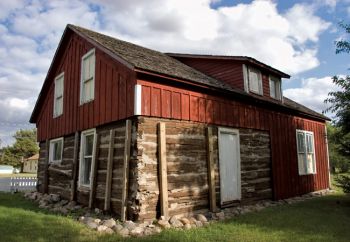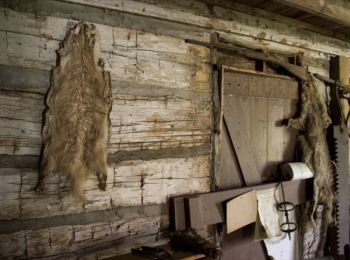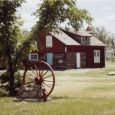The Gift of South Dakota
Subscriptions to South Dakota Magazine make great gifts!
Subscribe today — 1 year (6 issues) is just $29!
A Village Begun by Old Papineau
Editor’s Note: This story is revised from the May/June 2008 issue of South Dakota Magazine. To order a copy or to subscribe, call 800-456-5117.
Every town has someone who knows its history. In Geddes, it’s Ron Dufek. By day he runs Duf’s Amoco, but he’s also the town historian and caretaker of the Geddes Historical Village.
The village started in 1971 when Dufek, Vern Burnham and others decided to move the old Papineau Trading Post into town. “The city fathers were against it,” Dufek recalled. “We had to promise an arm and a leg to get it in here. We had one year to get it looking good.”
They succeeded, and other items followed, including part of the quaint WNAX gas station. Yankton businessman D. B. Gurney created “fair price” gas stations in the 1930s and sold gas for as little as 17 cents per gallon.
Students in Jackson Township, southwest of Geddes, attended the red, white and blue schoolhouse from 1901 to 1948. “Patriotic immigrants who loved their country” built the school and give it its unique color scheme, Dufek said. In 1960 Jackson Township bought the school and gave it to the Charles Mix County Historical Restoration Society. It was moved into the village in 1975.
A collection of small, white tombstones from the DuCharme Cemetery sits next to the trading post. One legend says the cemetery, which sat near the post’s original location, was where colorful fur trader Cuthbert DuCharme, also known as Old Papineau, buried all the people he killed. It held 27 men, women and children who died between 1869 and 1895. After Fort Randall Dam was built in the 1950s, the Missouri River’s new flow washed the cemetery away. The Army Corps of Engineers removed the remains and interred them at different locations. In many cases the original grave markers were left. They were added to the village in 1984.
When the childhood home of popular governor Peter Norbeck was deteriorating and about to be demolished, Dufek and Burnham intervened. “I just jumped right on it. One thing led to another and they gave it to us,” Dufek recalled. The home was moved into the village shortly before the South Dakota centennial in 1989.
The newest additions to the village include part of a replica Lewis & Clark keelboat and a claim shanty. The boat was built in Omaha for the bicentennial celebration of Lewis & Clark’s expedition in 2004.
Homesteader Charles Phillips moved to Dakota Territory from Kansas in 1883 and built the claim shanty around 1900. His nephew, William Phillips, donated the building to the historical society and it became part of the village in 2007.
Dufek plans to keep growing the village. “Maybe we’ll get it done if I last long enough,” he chuckled.
To learn more about the village, or to arrange a tour, visit the Geddes Historic Village website or call Duf’s Amoco at 605-337-2501.












Comments
Michele (Cummings) Richter
take care,
joe
Thanks to all who have spent so much time and effort in preserving family history.
Sandi